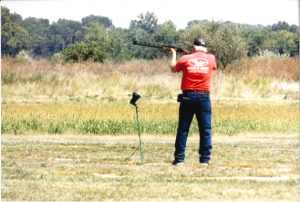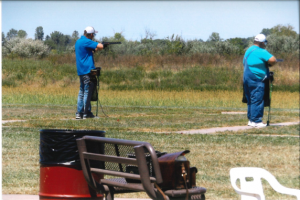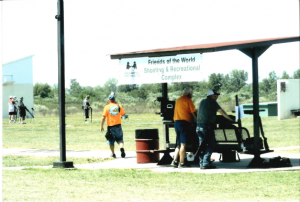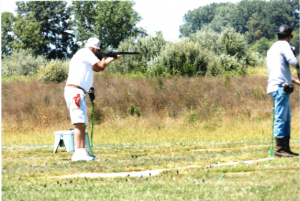By Larry Sterett |Contributing Editor

This shooter powdered the bird using a high ventilated rib single barrel shotgun. Such high rib shotguns are becoming more common and popular, although they have been available for more than three decades, as have adjustable ventilated ribs.
With an earlier start than normal, the 2019 Grand American Tournament at the World Shooting Complex north of Sparta, Illinois, began July 31, with Bob Fritz of Staunton emerging as the Grand American Handicap champion, shooting from 22.5 yards.
Fritz had shot some as a young man, but took several years off to raise a family; “…we had kids and I couldn’t afford it [the shooting].” About a decade ago he got back into the game again, and on Aug. 10 he emerged the best of the 2,002 shooters entered in the Grand American Handicap.
This year’s early opening may have been due to local schools beginning earlier; most of the trap boys/girls are local students from the Sparta area, and finding replacement help could be difficult.
The Grand—2019 is the 120th year for this trapshooting event–is definitely a world shooting event, and for this year the attendance figures were expected to be slightly above last year’s 4,800-plus participants. On Aug. 6, the first day of Grand week, there were 105 more shooters on the line than last year, and preliminary week had 278 more shooters.
It is not surprising to see shooters from Canada—Ontario, Saskatchewan, Manitoba, etc.— on the line, or some European nations from time to time. Last year there were more than six dozen shooters from Brazil competing; this year it was down slightly to around five dozen and while none have won the GA Handicap, don’t be surprised when one, or more, get their name and photograph on the GAH winners wall. At least two—Moacir Goulart and Maicon Soares—of the Brazilian group have been here three previous years.
Goulart stated, “It’s the championship of the world. It’s a good time.”
Soares, using a Portuguese-to-English phone app, mentioned, “Talking to shooters from other countries, interacting and trying to make friends,” is enough to bring him back. “It’s the camaraderie among the shooters,” he said.

The shooter on the left has called for the bird, while the shooter to the right waits.
In honor of those shooters from other countries their national anthems were played at opening ceremonies. Brazil’s ahem on Monday, August 5th, Australia’s (six shooters) on Aug. 3, and New Zealand (a baker’s dozen plus) on Aug. 4. The American and Canadian anthems were played as usual with the others following.
Males, young or older, are not the only shooters at the Grand. Martha Humphrey of Rush, Kentucky, makes the six-hour drive to Sparta an annual pilgrimage and 2019 was her 26th year.
“I come every year,” she said. “I love my friends. Shooting and fellowship. I think it’s a combination of both of them. It’s like family I would never think of not doing it.”
She planned to shoot in each of the 24 events during the ten days of the Grand.
“I’ll drink plenty of Gatorade,” she stated. “I have ice packs and I have a little fan. I’m prepared for it (the hot temperatures).”
Temperatures at the 2019 Grand were not as high as some a decade or so in the past when the lowest was around the 100-degree mark.
The 2018 Grand American Handicap winner was 15-year-old Kelan Kinion, of Middletown, Missouri, with a perfect 100 from the 21.5-yard line. In the 120 years of the Grand American Handicap no winner has ever repeated, but Kelan is young enough he just might…if he concentrates and doesn’t let the PRESSURE get to him. All he has to do is break one target at a time until all 100 are broken.
The Tuesday evening of the Grand week sees the annual Hall of Fame banquet hosted in the Entry Building, and this year’s inductees—Daniele Perazzi, Charles Long, Stuart Welton, and Louie Morgan–were definitely deserving of the honor.
Daniele Perazzi, who died in 2012 at age 80, was born the son of a northern Italy cobbler, with no connection to the firearms industry. At age 15 he went to work as a cleaner in a small gun factory. Cleaner, yes, but an observant one with ambition and a desire to learn. A decade later he invented and patented a new trigger mechanism which he then marketed.
Eventually he went to work in the Breda & Franchi factory, but did not like the mass production process, and returned home to craft small parts for sale at local shoots. He also began crafting shotguns at home while working on a new design.

On the west end of the line, as shown here, are the practice and make-up fields, skeet houses, etc,
In 1957, at age 25, Daniele founded Armi Perazzi with a factory in Brescia, Italy. Working with Italian shooter Ennio Matterelli, Daniele perfected the new shotgun design with a goal of having it used to win an Olympic gold medal. This goal was achieved in 1964, only seven years after Armi Perazzi was founded, when Matterelli broke 198 out of 200 targets. That was the first Olympic medal. At the 2008 Beijing Olympics 11 of 15 trapshooting medalists used Perazzi shotguns. Four years later in London the Perazzi medalists increased by one, to 12 of 15, and since 1964 there have been 54 Perazzi trapshooting Olympic medalists.
That says a lot about the design, quality, and durability of what has sometimes been called The Ferrari of Shotguns.
In 1973 the Ithaca Gun Company began importing about 2,000 Perazzi shotguns per year into the U.S. Eight years later in 1981 Perazzi USA was incorporated in the U.S., and Daniele was often in attendance in the Perazzi Building at the Grand American. Daniele was not a mechanical engineer, and had no formal training in the field, but he did hold several U. S. patents. Plus, Perazzi shotguns were among the first to offer high ventilated ribs, adjustable ventilated ribs and screw-in choke tubes.
The biography for his Hall of Fame induction states: “He is being honored for his contributions to shooting, which include his genius creativity in gun design and manufacturing that left a lasting legacy in competition sport as well as in the field.”
Charles Long has to be the most prolific trap shooter of all times. Since 1973 he has shot 1.2 million registered targets, and was the first to register 200,000 targets each in singles, doubles, and handicap. At present he is the only shooter to have registered more than 300,000 targets in each discipline. If practice rounds were included Long could have shot more shotshells than the smaller ammo factories annual production of 20th Century yesteryear.
Unlike Stuart Welton, Louie Morgan didn’t get into trapshooting until he was in his mid-30s, but he had done a lot of hunting. At a local (Loveland, Ohio) gun club with a buddy he shot a couple of rounds “and I got hooked.”
“I just like to shoot,” he explained. “I’ve been doing it for 46 years. When I first started, I’d shoot 500 rounds a week. I wore out a couple 1100s. It’s like any other sport. You have to keep doing it until you figure what you want to do whether you’ll be good at it or not.”
Morgan has been an all-American team member 19 times, has recorded a singles average over 99 percent 15 times, and has broken 200 straight single 98 times. He won his first Grand American trophy in 1985, a dozen years after he shot his first registered targets.
Stuart Welton shot his first registered targets when he was age 12 years, and two years later he was back at the 27-yard line. The next year he won the overall singles title. His 2007 singles average was 0.997 on 3,000 targets, ranking him 10th in the ATA history book. At the 2012 Western Grand Welton and the late Leo Harrison III went 15 extra rounds for the AA singles title before Harrison withdrew.
“It’s a matter of concentration and work,” he said. “You definitely have to work at it. Realistically you can say your shooting is directly proportional to your concen-tration.” (Basically this is what late friend Clyde Bailey, the 1959 GA Handicap winner, told this writer some years ago.
“You need a gun you trust, a good eye, and concentration,” he continued. “Don’t worry about what the other shooters are doing.”
Clyde shot, and won, with a third-hand Winchester Model 12, with what he called a ‘tight choke.’
The BIG event of the Grand American is Event 24, the Grand American Handicap where shooters posted at their handicap yardage do their best to break 100 targets. If a shooter accomplishes this and no other shooter has the same score, he or she, is declared the winner and receives a large trophy, their name in the record book, and other assorted goodies, depending… If two, or more shooters have the same high score—number of targets broken—a shoot-off to determine the winner is necessary. However, you don’t have to break 100 to win, and a number of years the winning score was 99, or even 98. It all depends on the weather, the shooters participating, concentration, and possibly luck.
According to Fritz, “I shot out of my mind today. I won’t lie about it. Everything just fell into place today. I missed a straightaway on the first one out… Then I said ‘The heck with it, just relax.’ I was having some problems aiming my gun, not pointing. I concentrated a little bit more today.”
Concentrate he did, breaking the next 99 birds straight.
Fritz broke 99 birds out of 100, but so did Kentuckians Jamie Hardesty and Ed Harris, and Jeff Rempel from Minnesota. In the shoot-off, Fritz (22.5 yards), Hardesty (21 yards) and Rempel (22 yards) shot together on the same field, while Harris (24.5 yards) was assigned to a different field by himself due to his longer yardage.
As Fritz stated, “I’d rather be with other people [shooters]. When I shot today we only had two people, just me and another guy. That’s tough when you don’t have a full squad. You can keep the rhythm [with a full squad]. Otherwise you have to wait in-between; you have to make your own rhythm and there is more pressure”
In the shoot-off, Fritz, who shoots a Krieghoff K-80, went straight, although a couple of early targets were broken, but not powdered.
“I knew I had it won already, because they [Hardesty and Rempel] both missed two [targets],” Fritz said.
He learned a few minutes later that Harris, shooting alone on an adjacent field, had only missed one target. Four years ago Fritz placed 13th in the GA Handicap.

The shooter on the left has called for the bird, while the shooter to the right waits.
“I’ve been in a slump,” he explained. “I got lucky. I’d rather be lucky than good.”
Queried as to whether he was nervous during the shoot-off, Fritz responded: “Oh yeah. I was nervous. I won’t lie about it. I was very nervous.” However, he didn’t think being nervous during the shoot-off would affect his sleep on Saturday night; “I’m going to go home and have a couple of Scotch and waters.”
At Vandalia, Ohio, the GAH used to be held on Friday, the next to last day, which allowed people to congratulate the new Champion on Saturday, the last or final day. Most of the exhibitors were still present, and lots of people—shooters and non-shooters—were going in and out of the exhibitor’s buildings behind the line; only a few were starting to close as there was still Saturday. No more. The powers that be decided to move the GAH to Saturday at the Sparta Complex, although the closing ceremonies were held on Friday, with ending ceremonies held on Saturday. BIG ERROR IN JUDGEMENT, as far as this reviewer and some others talked to are concerned.
If you came to the Complex to view some new shotguns, etc., you were out of luck. By noon on Saturday approximately three-quarters of the exhibitor building on the west end were locked or already empty, including Remington, the sponsor of the GAH, the NRA, and White Flyer targets. Even the Shell House was closed and the Central Entry Building was close to empty, except for the restaurant, the clothing shop and local info tables with Illinois maps, etc. The same comments apply to the tent exhibitors on the east end of the line. There were bare areas left between the few remaining tents; even the Randolph County Farm Bureau ice cream tent was absent, although you could still get a sandwich, etc. Unless you were shooting in the GAH, there was almost nothing to see or do, as there used to be when the Handicap was held on Friday in the golden days of yore.
During the Grand Week there is usually plenty to see and do if you are not busy shooting. The Museum, just to the west of the main entrance to the Complex, is always worthwhile, and strolling the vendor line behind the firing line is always interesting—new shotguns to see, etc, and sometimes clothing bargains including T-shirts, regular shirts, shooting vests and jackets, and more, plus literature. On Monday, Tuesday, and Wednesday in the main Entry Building there is usually Bingo for the females, and the winners can receive a few extra bucks to spend.



